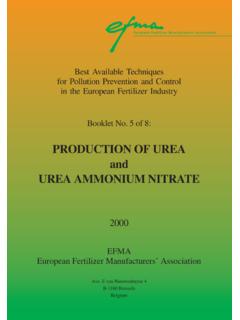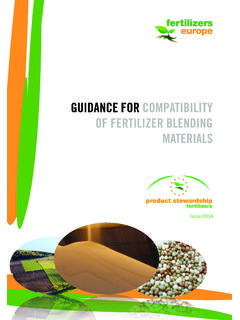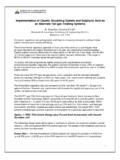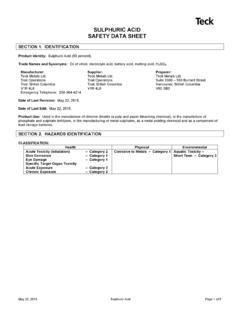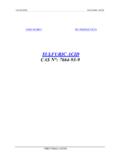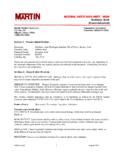Transcription of PRODUCTION OF PHOSPHORIC ACID - Product …
1 Best Available Techniquesfor Pollution Prevention and Controlin the European Fertilizer IndustryBooklet No. 4 of 8: PRODUCTION OF PHOSPHORICACID 2000 EFMAE uropean Fertilizer Manufacturers AssociationAve. E van Nieuwenhuyse 4B-1160 BrusselsBelgium Best Available Techniquesfor Pollution Prevention and Controlin the European Fertilizer IndustryBooklet No. 4 of 8: PRODUCTION OF PHOSPHORICACID Copyright 2000 EFMAThis publication has been prepared by member companies of theEuropean Fertilizer Manufacturers Association (EFMA).
2 Neither theAssociation nor any individual member company can accept liabilityfor accident or loss attributable to the use of the information given inthis Booklet. 2 Hydrocarbon feedWaterAirAmmoniaBooklet No. 1No. 2 Water AirWaterSulphurWaterPhosphate rockPhosphoric AcidSulphuric AcidNitric AcidNo. 5 UreaUANANCAN NPK(nitrophosphate route) NPK(mixed acid route)K, Mg, S,micronutrientsCalciumcarbonatePhosphat e rockK, Mg, S,micronutrientsNo. 6No. 7No. 8No. 4No. 3 Phosphate rock 3 CONTENTS PREFACE4 DEFINITIONS61.
3 INTRODUCTION72. DESCRIPTION OF PRODUCTION Raw Materials for PHOSPHORIC acid Principles of the PRODUCTION Emission Gypsum Disposal273. DESCRIPTION OF STORAGE AND TRANSFER Raw Materials PHOSPHORIC acid Storage294. ENVIRONMENTAL Input Output Emissions and Environmental Hazards Associated with Emissions and Wastes315. EMISSION Radioactivity336. MAJOR HAZARDS337. OCCUPATIONAL HEALTH & SAFETY338. SUMMARY OF BAT EMISSION Achievable Emission Levels for New Achievable Emission Levels for Existing Cost of Pollution Control Measures359.
4 REFERENCES35 GLOSSARY OF TERMS36 APPENDIX 1 Emission Monitoring in PHOSPHORIC acid Plants39 APPENDIX 2 General Product Information on PHOSPHORIC Acid42 4 PREFACE In 1995, the European Fertilizer Manufacturers Association (EFMA) prepared eight Bookletson Best Available Techniques (BAT) in response to the proposed EU Directive on integratedpollution prevention and control (IPPC Directive). These booklets were reviewed andupdated in 1999 by EFMA experts drawn from member companies. They cover the produc-tion processes of the following products:-No.
5 1 AmmoniaNo. 2 Nitric AcidNo. 3 sulphuric acid (updated in collaboration with ESA)No. 4 PHOSPHORIC AcidNo. 5 Urea and Urea Ammonium Nitrate (UAN)No. 6 Ammonium Nitrate (AN) and Calcium Ammonium Nitrate (CAN)No. 7 NPK Compound Fertilizers by the Nitrophosphate RouteNo. 8 NPK Compound Fertilizers by the Mixed acid RouteThe Booklets reflect industry perceptions of what techniques are generally considered to befeasible and present achievable emission levels associated with the manufacturing of the prod-ucts listed above. The Booklets do not aim to create an exhaustive list of BAT but they high-light those most widely used and accepted.
6 They have been prepared in order to share knowl-edge about BAT between the fertilizer manufacturers, as well as with the regulatory Booklets use the same definition of BAT as that given in the IPPC Directive 96/61 ECof 1996. BAT covers both the technology used and the management practices necessary tooperate a plant efficiently and safely. The EFMA Booklets focus primarily on the technologi-cal processes, since good management is considered to be independent of the process industry recognises, however, that good operational practices are vital for effective envi-ronmental management and that the principles of Responsible Care should be adhered to byall companies in the fertilizer business.
7 The Booklets give two sets of BAT emission levels:- For existing PRODUCTION units where pollution prevention is usually obtained by revampsor end-of-pipe solutions For new plants where pollution prevention is integrated in the process designThe emission levels refer to emissions during normal operations of typical sized levels may be more appropriate for smaller or larger units and higher emissions mayoccur in start-up and shut-down operations and in emergencies. 5 Only the more significant types of emissions are covered and the emission levels given inthe Booklets do not include fugitive emissions and emissions due to rainwater.
8 Furthermore,the Booklets do not cover noise, heat emissions and visual emission levels are given both in concentration values (ppm, ) and inload values (emission per tonne of Product ). It should be noted that there is not necessarily adirect link between the concentration values and the load values. EFMA recommends that thegiven emission levels should be used as reference levels for the establishment of regulatoryauthorisations. Deviations should be allowed as governed by:- Local environmental requirements , given that the global and inter-regional environ-ments are not adversely affected Practicalities and costs of achieving BAT PRODUCTION constraints given by Product range, energy source and availability of rawmaterialsIf authorisation is given to exceed these BAT emission levels.
9 The reasons for the deviationshould be documented plants should be given ample time to comply with BAT emission levels and careshould be taken to reflect the technological differences between new and existing plants whenissuing regulatory authorisations, as discussed in these BAT wide variety of methods exist for monitoring emissions. The Booklets provide examplesof methods currently available. The emission levels given in the Booklets are subject to somevariance, depending on the method chosen and the precision of the analysis.
10 It is importantwhen issuing regulatory authorisations, to identify the monitoring method(s) to be in national practices may give rise to differing results as the methods are notinternationally standardised. The given emission levels should not, therefore, be considered asabsolute but as references which are independent of the methods would also advocate a further development for the authorisation of fertilizer plants can be complex, with the integration of several PRODUCTION processes and they canbe located close to other industries.

